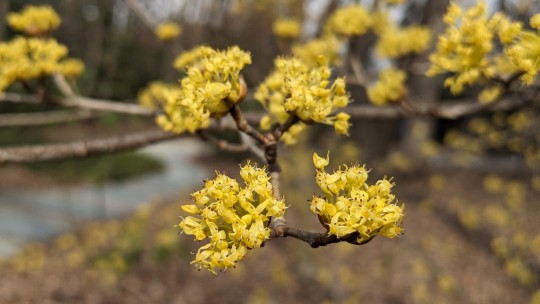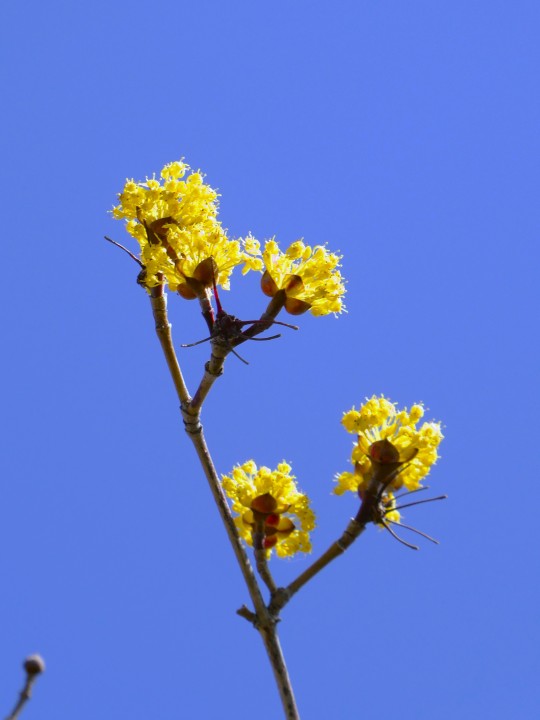#Japanese cornel dogwood
Explore tagged Tumblr posts
Text

Cornus officinalis / Japanese Cornel Dogwood at the Sarah P. Duke Gardens at Duke University in Durham, NC
#Cornus officinalis#Cornus#Japanese Cornel Dogwood#Japanese Cornel#Japanese cornelian cherry#Flowers#Nature photography#photographers on tumblr#Sarah P. Duke Gardens#Duke Gardens#Duke University#Durham#Durham NC#North Carolina
1 note
·
View note
Text



Shan zhu yu (Cornelius) in the blue sky
#shan zhu yu#cornelius#flower#blue sky#sky and flower#asiatic dogwood#Japanese cornel#Japanese cornelian-cherry
109 notes
·
View notes
Photo

131 notes
·
View notes
Text
Japanese Cornel Cherry
Cornus officinalis is a species of deciduous flowering plant in the dogwood family Cornaceae, native to China and Korea. Acid yellow flowers appear in early spring before lush leaves in summer, followed by bright red berries in the fall. Called sanshuyu in Japanese from its Chinese origin meaning ‘mountain silverberry’, it was imported from China in mid Edo era around 1722 for medicinal purpose. Today it is grown for ornamental gardens.
10 notes
·
View notes
Text
Smoothie Ideas
It’s been a little while and since I posted one of these and I’ve been asked by exactly no one to post another, so here we are! If I had access to all of these and a good amount of space to work with as well as room in a freezer, and a good blender/food processor, this is what I would do. All plant parts in equal amounts. Plus plain yogurt and silky tofu for texture. And honey, maple syrup, and cane sugar for added sweetness. Also assume anything toxic or potentially toxic (elderberries and pokeberry, for example) are properly prepared (cooked, seeds removed, etc.).
Drupe smoothie
açaí
acerola
allspice
amla
avocado
barberries: Darwin’s Japanese Ottawa
beautyberry
black huckleberry
brambles: Allegheny blackberry American raspberry arctic raspberry black raspberry blue raspberry boysenberry Canadian blackberry cloudberry common dewberry dewberry glandstem blackberry golden raspberry leafy-bracted blackberry loganberry Ohelo berry olallieberry Pennsylvania blackberry purple-flowered raspberry red raspberry salmonberry setose blackberry sphagnum dewberry swamp dewberry tayberry thimbleberry trailing raspberry wineberry youngberry
buffaloberry
camu camu
cashew apple
coffee cherry
crowberry
cupuaçu
dates: Barhi medjool
dogwoods: bunchberry cornel gray Kousa red osier silky
elderberries: common red
false Solomon’s seals: Canada mayflower false Solomon’s seal starry false Solomon’s seal
gandaria
genip
ginsengs: American Asian dwarf
hackberries: common sugarberry
harar
jujubes: ber black honey red
kinnikinnick
linden berry
longan
loquat
lychee
mamey sapote
mangos: ataulfo carabao Hayden Maya Palmer
miracleberry
mombins: ambarella imbu purple
mulberries: black red white
nance
Oregon grapes: creeping holly-leaved
partridgeberry
peach palm
pechiche
peppercorn
porcelainberry
rambutan
rose apples: Java jamun Malay water
silverberry
snowberries: common coralberry western
stone fruits: apricot American plum Bing cherry black cherry Canada plum chokecherry damson donut peach Mirabelle nectarcot nectarine peach pin cherry plumcot Rainier cherry sand cherry sloe sour cherry sugarplum
sugar palm
viburnums: arrowwood highbush cranberry mapleleaf viburnum nannyberry snowball tree squashberry witch’s hobblebush witherod viburnum
white sapote
wintergreens: creeping snowberry salal teaberry
2 notes
·
View notes
Photo







Cornus officinalis / Japanese Cornel Dogwood
PLANT COMMUNITY: N/A
NATIVE REGION: China, Korea, Japan
MATURE SIZE: Height and spread of 15-25′; large, spreading, multi-stemmed, deciduous shrub or tree
HABITAT/GROWING CONDITIONS: Grow in acidic, organically rich, medium moisture, well-drained soils in full sun to part shade; best performance occurs in cool summer climates
ECO-INDICATOR: N/A
HARDINESS ZONE: 5-8
LEAF COLOR: Dark green leaves, brown hair tufts in the vein axils on the leaf undersides; variable fall color ranges from drab pale yellow to attractive reddish-purple
FLOWER COLOR: Yellow flowers
FRUIT COLOR: Oblong red drupes
VALUE FOR REHABILITATION OF DISTURBED SITES: N/A
SOURCES: http://www.missouribotanicalgarden.org/PlantFinder/PlantFinderDetails.aspx?kempercode=b995
0 notes
Text
Forest Gardening – The Agroforestry Research Trust
A Forest Garden is a designed agronomic system based on trees, shrubs and perennial plants. These are mixed in such a way as to mimic the structure of a natural forest – the most stable and sustainable type of ecosystem in this climate.
The primary aims for the system are:
You're reading: Forest Gardening – The Agroforestry Research Trust
To be biologically sustainable, able to cope with disturbances such as climate change
To be productive, yielding a number (often large) of different products
To require low maintenance.
The crops which are produced will often include fruits, nuts, edible leaves, spices, medicinal plant products, poles, fibres for tying, basketry materials, honey, fuelwood, fodder, mulches, game, sap products. Forest gardens (often called home gardens) have been used for millennia in tropical regions, where they still often form a major part of the food producing systems which people rely on, even if they work elsewhere for much of the time. They may also provide useful sources of extra income. They are usually small in area, often 0.1-1 hectares (+61404532026 acres).
In temperate regions, forest gardens are a more recent innovation, over the last 30 years. A major limiting factor for temperate forest gardens in the amount of sunlight available to the lower layers of the garden: in tropical regions, the strong light conditions allow even understorey layers to receive substantial light, whereas in temperate regions this is not usually the case. To compensate for this, understorey layers in temperate forest gardens must be chosen very carefully.
Read more: One Thing I Wish Someone Told Me Before I Started a Succulent Garden
There are plenty of plant crops which tolerate shady conditions, but many are not well known. Many of the more common shrub or perennial crops need bright conditions, and it may be necessary to design in more open clearings or glades for such species. Temperate forest gardens are also usually small in area, from tiny back garden areas up to a hectare (2.5 acres) in size.
The key features which contribute to the stability and self-sustaining nature of this system are:
The large number of species used, giving great diversity.
The careful inclusion of plants which increase fertility, such as nitrogen fixers (eg. Alders [Alnus spp], Broom [Cytisus scoparius], Elaeagnus spp, and shrub lupins [Lupinus arboreus]).
The use of dynamic accumulators – deep rooting plants which can tap mineral sources deep in the subsoil and raise them into the topsoil layer where they become available to other plants, eg. Coltsfoot [Petasites spp], Comfreys [Symphytum spp], Liquorice [Glycyrrhiza spp], Sorrel (and docks!) [Rumex spp].
The use of plants specially chosen for their ability to attract predators of common pests, eg umbellifers like tansy.
The use, where possible, of pest and disease resistant varieties, eg. apples.
The increasing role of tree cover and leaf litter which improve nutrient cycling and drought resistance.
There is an excellent free app called Ticl (smart phone and web based) which allows you to walk around a garden with a smart phone and it will describe the plants nearest to you – or you can locate specific plants using a direction-finder. Online you can see a zoom-able map of the garden with location points marked on. If you visit the garden with a smart phone you can use Ticl to help identify what is growing!
Click here to see the ART forest garden. You need to log in to see all the plant points.
Designing in Layers
A forest garden is organised in up to seven ‘layers’ . Within these, the positioning of species depends on many variables, including their requirements for shelter, light, moisture, good/bad companions, mineral requirements, pollination, pest-protection, etc. The layers consist of:
Canopy Trees
– the highest layer of trees. May include species such as Chestnuts [Castanea spp], Persimmons [Diospyros virginiana], honey locusts [Gleditsia triacanthos], Strawberry trees [Arbutus spp], Siberian pea trees [Caragana arborescens] Cornelian cherries [Cornus mas], Azeroles and other hawthorn family fruits [Crataegus spp], Quinces [Cydonia oblonga], Apples [Malus spp], Medlars [Mespilus germanica], Mulberries [Morus spp], Plums [Prunus domestica], Pears [Pyrus communis], highbush cranberries [Viburnum trilobum].
Small trees and large shrubs
– mostly planted between and below the canopy trees. May includes some of the canopy species on dwarfing rootstocks, and others such as various bamboos, Serviceberries [Amelanchier spp], Plum yews [Cephalotaxus spp], Chinkapins [Castanea pumila], Elaeagnus spp, and Japanese peppers [Zanthoxylum spp]. Others may be trees which will be coppiced to keep them shrubby, like medicinal Eucalyptus spp, and beech [Fagus sylvatica] and limes [Tilia spp] with edible leaves.
Shrubs
– mostly quite shade tolerant. May include common species like currants [Ribes spp] and berries [Rubus spp], plus others like chokeberries [Aronia spp], barberries [Berberis spp], Chinese dogwood [Cornus kousa chinensis], Oregon grapes [Mahonia spp], New Zealand flax [Phormium tenax] and Japanese bitter oranges [Poncirus trifoliata].
Read more: Sauteed Garden Fresh Green Beans
Herbaceous perennials
– several of which are herbs and will also contribute to the ground cover layer by self-seeding or spreading. These may include Bellflowers with edible leaves [Campanula spp], Comfreys [Symphytum spp], Balm [Melissa officinalis], Mints [Mentha spp], Sage [Salvia officinalis], and Tansy [Tanacetum vulgare].
Ground covers
– mostly creeping carpeting plants which will form a living mulch for the ‘forest floor’. Some may be herbaceous perennials (see above), others include wild gingers [Asarum spp], cornels [Cornus canadensis], Gaultheria spp, and carpeting brambles (eg. Rubus calycinoides & R.tricolor).
Climbers and vines
– These are generally late additions to the garden, since they obviously need sturdy trees to climb up. They may include hardy kiwis [Actinidia spp], and grapes [Vitis spp].
Rhizosphere
– Any design should take account of different rooting habits and requirements of different species, even if root crops are not grown much. Some perennials with useful roots include liquorice [Glycyrrhiza spp] and the barberries [Berberis spp] whose roots furnish a good dye and medicinal products. Various beneficial fungi can also be introduced into this layer.
A long-term biologically sustainable system for growing food & other products for a household, school, community group etc.
Once established, little work is needed to maintain.
Planting out and establishment usually requires large numbers of plants and substantial work.
Source: https://livingcorner.com.au Category: Garden
source https://livingcorner.com.au/forest-gardening-the-agroforestry-research-trust/
1 note
·
View note
Photo








Cornus officinalis, Japanese Cornel Dogwood
Community: N/A
Native Region: China, Korea, and Japan, introduced to United States
Mature Size: height: 15-25′, spread: 15-25′
Habitat: Woodlands, mountains, high elevation forests, forest margins
Hardiness Zone: 5 to 8
Leaves: dark green leaves that turn drab pale yellow to attractive reddish-purple in the fall
Flowers: yellow
Fruit: oblong, red
Fruit: humans, birds
Seed Dispersal: birds
Collect Seeds: fall
http://www.missouribotanicalgarden.org/PlantFinder/PlantFinderDetails.aspx?kempercode=b995
http://www.pfaf.org/User/Plant.aspx?LatinName=Cornus+officinalis
0 notes
Text
Smoothie Ideas
Who asked? No one. But if I had access to all of these and a good amount space to work with as well as room in a freezer, and a good blender/food processor, this is what I would do. All plant parts in equal amounts. Plus plain yogurt and silky tofu for texture. And maple syrup, honey, and cane sugar for added sweetness.
Red smoothie
honey: fall
apples: Cortland empire Fuji honeycrisp Ida red jazz red delicious McIntosh starkrimson pacific rose pinata pink lady red crapbapple fruits and blossoms red prince
bearberry
blood orange
buffalo berry
cherries: Bing black choke pin sand sour
cherry tomatoes: black cherry cherry grape
Chinese bayberry
coffee cherry
cranberries: small large lingonberry
dogwood fruits: bunchberry cornel cherry Kousa
false Solomon’s seal fruit: Canada mayflower false Solomon’s seal starry false Solomon’s seal
ginseng berries: American Chinese
goji
haws: Chinese cockspur common downy dotted fireberry mayhaw
Jack-in-the-pulpit berry
Japanese barberry
mace
partridge berry
peppers: habanero red bell
plumcot
pomegranate
purple mombin
raspberries and blackberries: Allegheny blackberry American red raspberry Arctic raspberry black raspberry Canadian blackberry common dewberry dwarf red blackberry European blackberry European red raspberry glandstem blackberry loganberry Pennsylvania blackberry purple-flowered raspberry setose blackberry swamp dewberry thimbleberry trailing raspberry
red bean
red elderberry
red grape
red jujube
red mulberry
red plum
redcurrants: European northern skunk
reishi
rosehips and rose petals
spicebush berry
strawberries: garden Virginia woodland
sumacs: fragrant shining smooth staghorn
tamarillo
tulip petal
viburnum berries: highbush cranberry snowball tree berry squashberry
wintergreen berry
yew aril
3 notes
·
View notes
Photo

2 notes
·
View notes